A Virtual Fashion Show
The BC History of Nursing Society’s Margaret Scaia, Sheila Rankin Zerr and Lenore Radom presented a slideshow of nurses’ uniforms. Almost all were from Ms. Rankin-Zerr’s collection, some of which are shown below. Her study of attire worn by nurses reveals a great deal, not only about their struggle for professional status and recognition, but also about their roles within contemporary society, and about their independence. This presentation forms part of the 2021 Nursing History Symposium video.
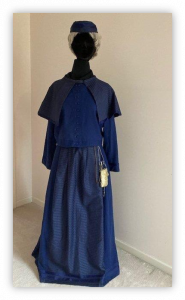 Jeanne Mance, born 1606, was founder of the first European-type hospital in Canada. She learned about health care from nuns. She administered the growing Hotel Dieu operations until her death in 1673. The costume is typical of her time for day wear, but little information exists about her hospital wear.
Jeanne Mance, born 1606, was founder of the first European-type hospital in Canada. She learned about health care from nuns. She administered the growing Hotel Dieu operations until her death in 1673. The costume is typical of her time for day wear, but little information exists about her hospital wear.
The fashion show also summarized the nursing career of “mover and shaker” Jessie MacKenzie, as a BC example of many early Canadian nurses striving to set standards for nursing in the early 1900s.
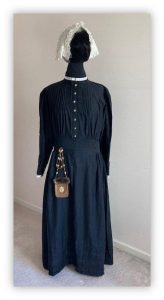 Lady Amelia Douglas (whose husband was to become the first governor of BC in 1858), was born in 1812 in northern Manitoba. She learned healthcare at the side of her mother, a Swampy Cree healer.
Lady Amelia Douglas (whose husband was to become the first governor of BC in 1858), was born in 1812 in northern Manitoba. She learned healthcare at the side of her mother, a Swampy Cree healer.
This costume is typical of everyday dress worn by “Women of Influence” in Victoria from the 1850s to about the 1890s. A First Nations beaded leather pouch would have been used to carry herbs and other potions to assist in healing work as was the chatelaine in this same time period worn by Florence Nightingale (and seen on the Mance replica).

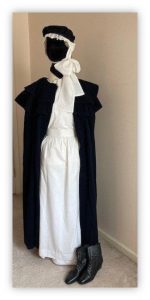
The uniform changes with the times, sometimes taking cues from the styles in vogue, sometimes setting the trends as seen in this circa 1905 Royal Jubilee Hospital (RJH) Walking Out Uniform and a 1960s miniskirt once worn by an instructor.
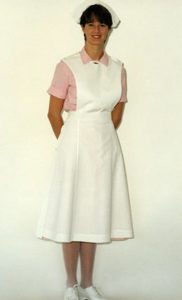

Nursing student uniforms reflect certain similarities across institutions and over long periods of time. Short sleeves and a stiffly starched bib apron introduced decades before, remain standard for students in 1960-1972 era.
Patti Stevenson models the UBC pink beside a RJH student nurse uniform in blue. Colours, adornment (or lack) on the cap, and the emblem on the collar of the cape distinguish schools.
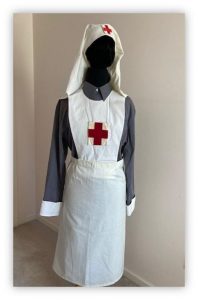

The Voluntary Aid Detachment (VAD) Uniform worn by nursing sisters in World War I were influential in causing women’s hemlines to be raised; floorlength skirts were simply unworkable in the mud of battlefields. After the war, this trend may have been responsible for the further raising of hemlines.

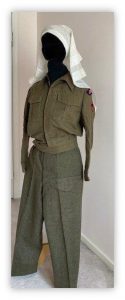
WWII uniforms worn in field hospitals were practical and echoed those worn by Canadian infantry. At home the wearing of trousers by women was widely adopted, as was the turban (not shown) that nurses fashioned from khaki slings as a more practical replacement for the veil or beret. In their distinctive blue dress uniform, Canadian nurses were known as “bluebirds”.
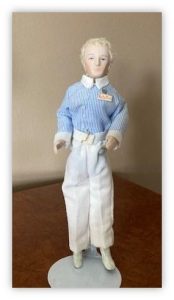
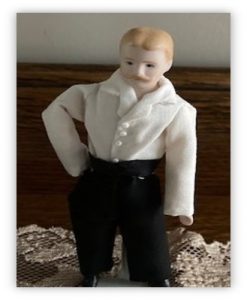
The male nurse has been part of nursing from earliest times. In the middle ages during the Crusades, they were the prominent care givers and have continued to serve in military zones. Today their presence in general nursing is increasing, but they still represent less than seven percent of registered nurses.
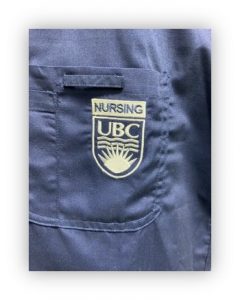

Originally black wool trousers and starched shirts were the uniform, then white trousers and tee shirts covered with a lab coat (or a lab jacket). Over time scrubs in a variety of colours have gradually become the norm for all nurses. Here is the current UBC nursing student uniform in UBC Navy with an identifying badge.


